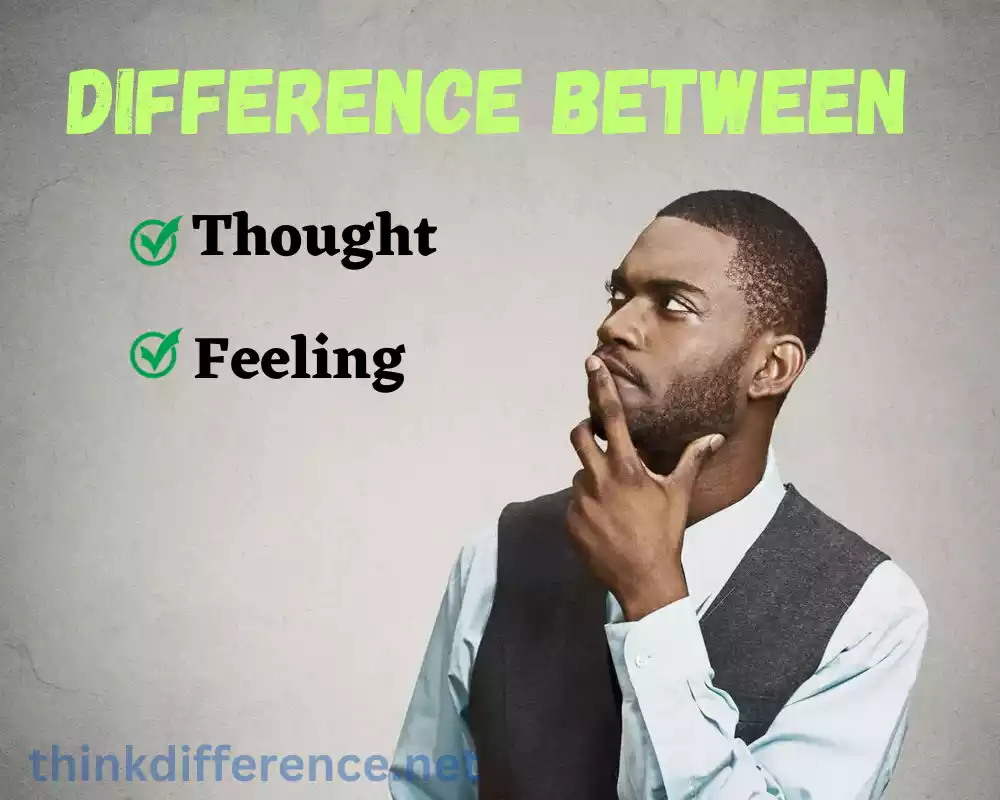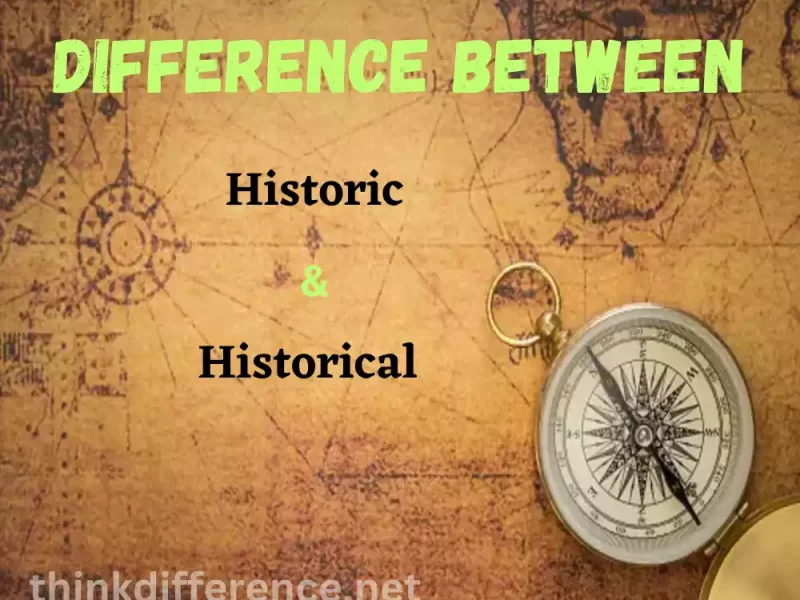Thought and Feeling have an indelible mark on our lives. They dictate everything from perspective and actions to emotional intelligence development and well-being. Understanding their intricate relationship allows us to leverage them more fully for emotional intelligence development. In this article, we’ll look into their effects on both. It will examine their role in positive thinking approaches for increasing emotional intelligence development as well as the impact of emotions on well-being.
Definition of Thought and Feeling
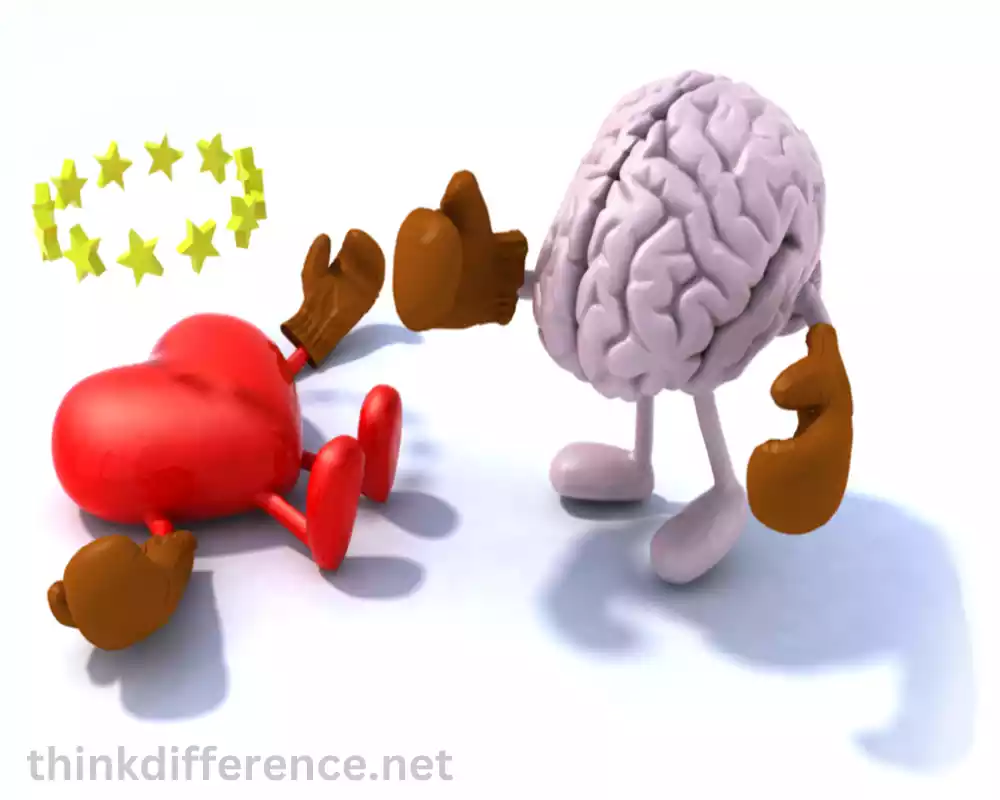
Thought: Thought is an activity and process characterized by conscious or unconscious reasoning and reflection that occurs while engaging in perception and memory activities as well as judgment, problem-solving, decision making, and critical thinking. Our beliefs, knowledge, experience, and sensory data from our senses often shape our thoughts.
Language allows them to be expressed clearly while they can also act spontaneously as data analysis systems allowing our thoughts to form their shape on attitudes, perceptions, and behavior patterns that shape us throughout life.
Feeling: Feelings are subjective emotional experiences that occur as responses to stimuli or situations, including conscious awareness and sensations of emotional states such as happiness, sorrow, anger fear, and joy. Feelings can be affected by personal experiences such as values temperament as well as interpretations of external events that we interpret differently.
Feelings are nonverbal yet difficult to describe in words while associated with physiological changes including breathing patterns heart rates muscle tension changes that inform us on how we’re feeling while shaping behavior decisions and shaping future choices.
Importance of understanding the difference between Thought and Feeling
Understanding the difference between feelings and thoughts is of vital importance for many reasons:
- Self-Awareness: Gaining self-awareness by distinguishing thoughts from emotions increases self-awareness. Individuals gain more insight into themselves by being aware of both sides, so that they may identify thoughts from emotions more readily and identify when these are different from each other. This process ultimately allows individuals to gain more of an understanding of themselves as individuals while distinguishing thoughts from emotions more efficiently.
- Emotional Intelligence: Emotional Intelligence refers to our capacity for distinguishing thoughts from emotions, understanding them and managing them accordingly. Knowing the differences can help individuals better comprehend both their own and others’ emotional states resulting in improved emotional regulation as well as enhanced interpersonal relations.
- Effective Communication: Communication success relies upon an ability to distinguish between thoughts and emotions, so people who can accurately articulate these can express them more efficiently without miscommunication and avoid misgivings. This understanding leads to better listeners as individuals can appreciate others perspectives better.
- Making decisions: In order to make smarter decisions, it’s crucial that individuals differentiate between feelings and thoughts. Thoughts involve rational analysis of information feelings rely more heavily on emotional influences such as intuition. By understanding both processes clearly, individuals can make better choices by taking into account both rational considerations as well as emotional influences when making their choices.
- Manage cognitive biases: Cognitive biases have the power to negatively influence decisions, problem-solving and other areas of life. Cognitive biases can be managed by understanding and managing differences between emotions and thoughts and being aware of any associated biases which might make rational and objective decisions easier for individuals.
- Emotional Well-being: Understanding the difference between feelings and thoughts is crucial for emotional well-being, enabling individuals to challenge any unhelpful or distorted thought patterns which contribute to depression or anxiety. Separating them allows individuals to cultivate healthier thinking habits as well as emotional resilience.
Understanding the difference between thinking and feeling can provide individuals with valuable insight into their inner processes, improve emotional intelligence and communication abilities, support effective decision-making processes, combat cognitive biases and support overall emotional well-being.
Characteristics of Thought
- Cognitive Process: Thinking is a cognitive activity encompassing various mental activities like perception, attention and memory as well as reasoning and problem solving. It is the mental activity that occurs when we engage in information processing and mental representation.
- Rational and Logical: Thoughts are characterized by rationality and logical reasoning. They involve the ability to analyze, evaluate, and make sense of information. Thoughts are based on facts, evidence, and logical connections between ideas.
- Analysis and Problem-Solving: Thoughts often involve the analysis of information and the ability to break down complex concepts into smaller components. They are instrumental in problem-solving, as they help us generate solutions, consider different perspectives and evaluate potential outcomes.
- Verbal or Language-Based: Thoughts are commonly expressed through language. They involve the use of internal dialogue, mental conversation or self-talk. Thoughts can be in the form of words, sentences or mental images that represent ideas and concepts.
- Influenced by Beliefs, Knowledge and Experiences: Beliefs, knowledge and past experiences all shape our thoughts. They are shaped by our cultural background, education, social environment and personal values. Our thoughts can be influenced by biases, assumptions and preconceptions that we hold.
- Conscious and Unconscious: Thoughts can be conscious, meaning we are aware of them and actively engage with them. Thoughts can also be unconscious or automatic, occurring without our conscious awareness. Unconscious thoughts can still influence our behavior and decision-making.
- Dynamic and Fluid: Thoughts are not static entities. They are dynamic and can change time. They can be flexible, adaptable, and open to revision based on new information or insights. Our thoughts can evolve as we gain new knowledge and experiences.
- Internal Mental Constructs: Thoughts are internal mental constructs that exist within the mind. They are not directly observable by others but can be inferred through behavior, verbal expression and communication.
Thoughts are cognitive processes characterized by rationality, logical reasoning, analysis and problem-solving. Influences that shape perceptions include our beliefs, experiences and knowledge each has an integral part to play in shaping perceptions, understanding and decision-making processes.
Characteristics of Feeling
- Emotional Response: Emotions refers to our consciousness of feelings as well as emotional reactions in response to stimuli or events, creating experiences such as happiness, fear, sadness, anger and joy as well as love among many other emotions.
- Subjective and Personal: Feelings are highly individual and subjective experiences. Each person can have differing duration, intensity and interpretations of them in response to similar events in his/her environment. How one individual experiences one situation may differ significantly from how another perceives the same event or circumstance.
- Bodily and Sensory Sensations: Feelings don’t just include emotions alone; they also incorporate bodily sensations. Emotions often manifest physically through feelings such as an enthralled heartbeat or stomach butterflies or tightened muscles – meaning these bodily sensations could also contribute to feelings.
- Express Your Feelings Nonverbally: Emotions can often be expressed nonverbally through cues, gestures and expressions such as body language, facial expressions or tone of voice and gestures – they’re difficult to put into words due to being complex and multi-layered.
- Influenced by prior experiences values and temperament: Emotions are determined by an array of variables including past personal experiences as well as cultural or individual temperament influences and perceived events; our interpretation and meaning assignation determine our emotional reactions and responses.
- Automated and spontaneous: Feelings may arise rapidly and spontaneously when activated by external events as well as internal memories or thoughts; often without conscious control by us.
- Feelings as Key Element for Decision and Behavior: Feelings are an integral component in decision-making and behavior choices, providing us with important insight and information regarding things that matter most to us while serving as guides for values as well as reactions in various circumstances. How we feel affects both choices made as well as any actions decided upon.
- Multidimensional: Feelings can be multidimensional for instance, they could include feelings that blend multiple emotions at once such as feeling both nervous and excited simultaneously or experiencing mixed joy-sadness simultaneously. While pinpointing each specific emotion can sometimes be hard, multiple ones often combine into distinct ones creating distinct ones.
- Changeable and Temporary: Emotions can change at any moment in their entirety and for no apparent reason. Their intensity, duration or even emotion change over time as their experiences evolve as an effect of both external and internal factors.
- Valuable Sources of Information: Highly reliable sources of information they are reliable tools for exploring psychological wellbeing as well as needs and wants, acting as reliable signals that tell us when something doesn’t feel quite right or brings satisfaction and joy in our lives. Recognizing and understanding emotions will allow us to navigate life more successfully.
Sentiments are subjective emotions which arise within individuals as an emotional response, including physical sensations, bodily sensations and nonverbal expression. Influenced by experiences as well as values and temperament, feelings provide information which may assist individuals when making decisions or understanding themselves better.
Differentiating Between Thought and Feeling
Understanding our inner experiences and their influence on behavior, perceptions and overall health requires being able to distinguish between feelings and thoughts. Although they’re intertwined there are various methods that can help differentiate them.
Language and Expression:
- Thoughts: Thoughts are primarily language-based and can be easily verbalized or written down. They involve the use of words, sentences or mental images to represent ideas, concepts or mental processes. Thoughts can be communicated and shared with others through language.
- Feelings: Feelings are often nonverbal or challenging to express in words. They are more subjective and sensory in nature, involving emotional experiences and bodily sensations. Communication of emotion takes many forms, from body language and facial expressions, to voice tone.
Sensory Experience:
- Thoughts: Thoughts are mental processes and do not typically involve direct sensory experiences. Mind games exist solely within our heads and have nothing to do with physical sensations felt throughout the body.
- Feelings: Feelings are associated with sensory and bodily experiences. Feelings can manifest themselves through physical sensations such as an uncomfortable stomachache, increased heartbeat or tears streaming down from our eyes. Feelings have a more embodied quality and can be felt throughout the body.
Subjectivity and Objectivity:
- Thoughts: Thoughts can often be thought to transcend simple rational and objective analysis. Thinking relies upon mental processes, logic analysis, problem-solving skills and analysis capabilities that are judged against evidence or facts along with its coherence and logic.
- Feelings: Feelings are subjective experiences which depend heavily on an individual’s beliefs, values and experiences. Like thoughts, people’s feelings cannot easily be evaluated or assessed since they mirror personal emotional reactions and personal preferences.
Cognitive and Emotional Processes:
- Thinking: Thinking is linked with cognitive processes such as perception memory judgment and reasoning. These thoughts could either be conscious or subconscious and pertain to processing information and solving problems.
- Feelings: Emotions can be defined by both processes and awareness. Feelings include joy, sadness, anger and fear – emotions we often connect to the various parts of the body whose chemistry changes affect our emotions and affect overall mental wellbeing.
Recognizing how emotions and thoughts are inextricably intertwined is critical in developing emotional intelligence and managing experiences more successfully. Our thoughts can cause or alter emotions while emotions can alter perceptions or cause them altogether. Knowing the difference can provide us with better knowledge to navigate experiences more successfully as well as effectively communicate to improve communication, relationships and emotional intelligence.
Relationship between Thought and Feeling
Thought and emotion are intricately interlinked processes. Though separate, they frequently influence and interact with one another in meaningful ways that impact both.
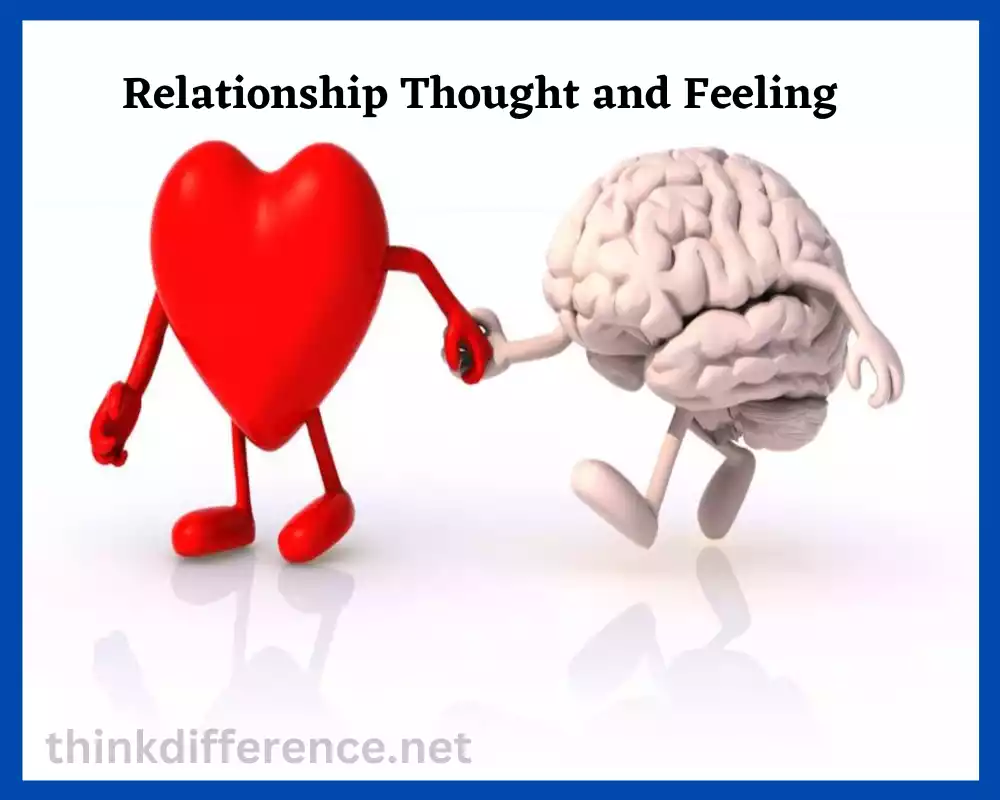
Influence of Thoughts on Feelings:
- Cognitive Appraisal: Our thinking patterns and interpretations can have a great effect on how we react emotionally, both at an event level as well as overall. Based upon how we assess it from our beliefs will dictate both its strength and character of feelings we experience. For example interpreting something we hear as criticism may trigger anger or hurtful responses in us.
- Beliefs and expectations: Our core belief systems and assumptions can have an enormous impact on how we think, which in turn influences our emotional experience. If we accept negative beliefs about ourselves or about society at large, this could result in even more negative thoughts becoming manifest, creating even stronger negative emotions in us all.
- Cognitive Restructuring: By actively challenging our beliefs and perceptions, we are able to alter them for better emotional responses. Cognitive-behavioral therapy (CBT) often employs this strategy in helping patients create more adaptive thought and feelings patterns.
Impact of Feelings on Thoughts:
- Bias in Thinking: Emotions have the power to significantly affect our thinking processes and decisions. When experiencing intense emotions like anger or fear, our thinking could become impaired due to how intensely these feelings impact us – potentially leading us towards making snap decisions or developing biased or impulsive habits of thinking.
- Memory and Recall: Emotions have an outsized influence on memory retention and recall ability, leading to either improved or degraded recall, depending on our emotions at any given moment. Strong emotions may strengthen or weaken it depending on their impact upon ideas and data that we employ in any given circumstance.
- Gut and intuition: Our bodies provide intuitive signals – or “gut feelings” which guide our thinking and decision-making, especially in situations requiring swift assessments. These intuition signals can prove especially helpful during emergency assessments that must take place quickly.
Feedback Loop:
- Mutual Reinforcement: Thoughts and emotions often reinforce each other in an ongoing feedback loop. Negative thoughts may trigger negative emotions which in turn spark additional negative thinking which perpetuates itself and further intensify this vicious circle of negativity. Conversely, positive emotions can increase through positive thought leading to increased happiness levels and feelings that reinforce that increase happiness levels further still.
- Emotional Valence: Our emotions can be measured based on their value (positive and negative). Positive thoughts often correlate to positive emotions while negative ones often produce unpleasant ones – this allows us to increase their impact by understanding where our minds and hearts lie.
Regulation and Integration:
- Emotional Regulation: Understanding the connection between emotions and thoughts allows us to control them more effectively, by actively controlling thoughts, challenging negative thought patterns and engaging in self-calming exercises that may influence emotional experiences.
- Mindfulness and Acceptance: Meditation exercises such as mindful can assist us in being aware of our thoughts and emotions without judgement while cultivating feelings of acceptance to diminish negative thoughts that cause emotions to flare.
Understanding how emotions and thoughts interact is integral for building self-awareness, emotional intelligence and making more rational and well-informed decisions. Learning to control our emotions is also integral for overall wellness and creating peace and stability within daily life.
Importance of Balancing Thoughts and Feelings
Balance between our feelings and thoughts is integral for overall well-being and decision making efficiency and here are the main reasons to explore this technique:
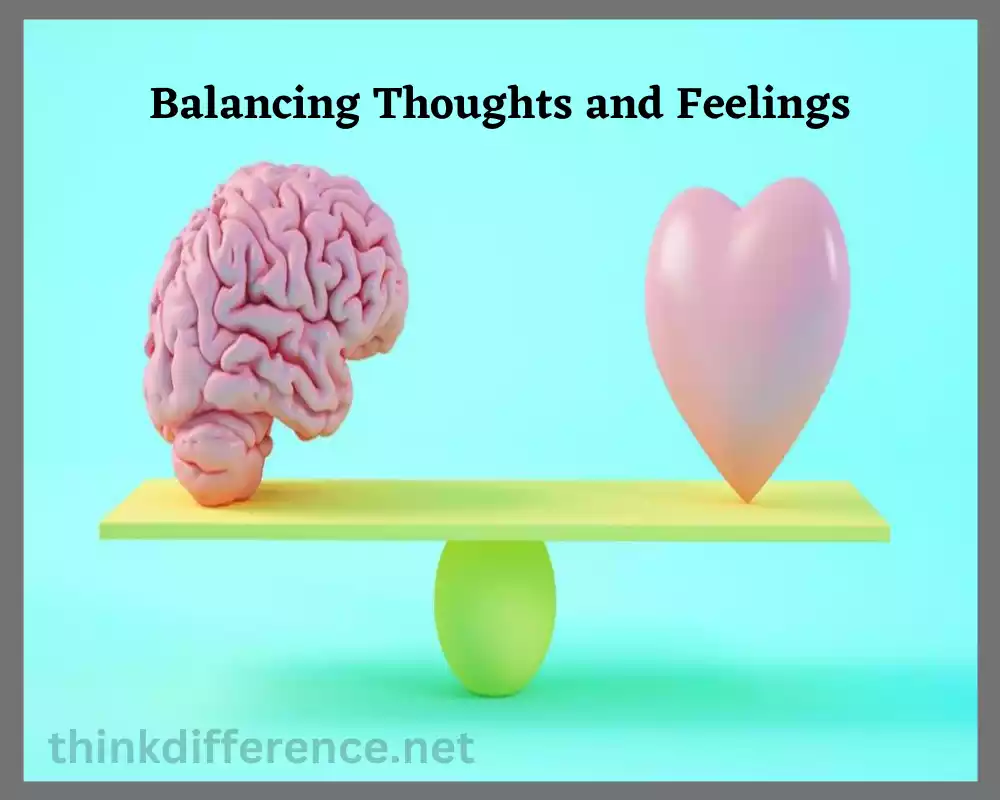
- Holistic Decision-making: Balancing thoughts and feelings allows for a more comprehensive decision-making process. Relying solely on thoughts can lead to a purely rational approach, potentially overlooking important emotional factors. Incorporating feelings provides valuable insights into personal values, desires and intuitive guidance, leading to more holistic and well-rounded decisions.
- Emotional Intelligence: Balancing thoughts and feelings enhances emotional intelligence. It involves understanding and managing both cognitive and emotional aspects of oneself and others. Emotionally intelligent individuals are aware of their emotions, can navigate them effectively and recognize the impact of emotions on their thoughts and behaviors.
- Authenticity and Self-Expression: Balancing thoughts and feelings enables individuals to express themselves authentically. Acknowledging and expressing emotions helps in communicating one’s true experiences and needs. Ignoring or suppressing emotions can lead to internal conflicts and hinder effective self-expression.
- Enhanced Problem-solving: Considering both thoughts and feelings in problem-solving processes can lead to more creative and innovative solutions. Emotions can provide intuitive insights, novel perspectives and alternative approaches that may not be apparent through rational thinking alone. Balancing thoughts and feelings broadens the range of possibilities in finding effective solutions.
- Improved Relationships: Balancing thoughts and feelings is crucial for building and maintaining healthy relationships. By recognizing and validating both one’s own and others’ emotions, individuals can establish empathetic connections. Balancing thoughts and feelings allows for effective communication, understanding diverse perspectives and resolving conflicts constructively.
- Emotional Well-being: Ignoring or neglecting emotions can lead to emotional distress and impact overall well-being. Balancing thoughts and feelings promotes emotional self-care and resilience. It involves acknowledging and addressing both positive and negative emotions, fostering emotional regulation and cultivating a sense of emotional balance.
- Authentic Self-awareness: Balance between thoughts and emotions can lead to greater insight into yourself, helping people better comprehend your needs, values and wants as well as understanding why certain thoughts or emotions surfaced in the first place. Genuine self-awareness is integral for personal development in terms of accepting yourself fully while living the life you envision for yourself.
Balance between emotions and thoughts helps people make informed decisions, develop emotional intelligence, improve relationships, foster well-being and gain greater awareness of others and themselves. Achieve equilibrium between our emotional lives and intellectual endeavors results in more balanced and satisfying lives for everyone involved.
Practical Applications
Understanding the relationship between emotion and cognition can have many applications throughout our lives, from business decisions to personal interactions.
Here are a few areas this knowledge could benefit us:
- Emotional Regulation: Understanding how your thoughts impact your emotions can help in effectively managing and regulating them. By challenging negative or deformed thoughts, individuals can reduce emotional intensity while increasing positive ones and create more beneficial feelings in themselves and those around them.
- Cognitive Restructuring: Cognitive restructuring techniques can assist individuals in shifting away from negative thought patterns towards more flexible, positive thoughts that contribute to an enhanced state of mind and positive outlook about life. This process may ultimately result in improved physical, psychological, emotional health.
- Balance Emotions and Thoughts in Decision-Making: Balancing emotions with thoughts in decision making can result in more informed and comprehensive choices that align with personal values and wellbeing. Exploring both logic as well as emotional reactions provides a comprehensive analysis that leads to wiser choices aligned with your values.
- Communications: Understanding how emotions and thoughts interact is integral to effective communication, as it allows individuals to share their thoughts and emotions authentically while meeting needs or perspectives expressed by others. Understanding this relationship strengthens relationships.
- Understanding and Empathy: Recognizing how emotions and thoughts impact one another can increase empathy and understanding between people. By helping individuals recognize that different thoughts can trigger different emotional responses, increasing compassion while decreasing judgmental attitudes is promoted.
- Stress Management: By becoming aware of their emotions and thoughts, people can more effectively identify and treat stress-inducing triggers. Through self-analysis of negative patterns of thinking they can implement techniques designed to lower stress in order to maximize overall well-being and wellbeing.
- Self-Reflection and Personal Growth: Examining the relationship between thoughts and emotions encourages reflection and self-reflection, helping individuals discover what drives their emotional or mental responses – something which contributes to personal development as they gain more of an insight into who they truly are as individuals.
- Development of Emotional Intelligence: Recognizing the connection between emotions and thoughts is central to emotional intelligence development. Being conscious of your emotional responses requires being aware of them while understanding their impact on thoughts, behavior and relationships is paramount in creating this intelligence.
Applying this knowledge through practical means allows people to improve their emotional well-being, make smarter decisions more quickly, improve communication skills, manage anxiety better and cultivate harmonious relationships more easily. Understanding the link between feelings and thought enables individuals to lead more balanced and fulfilling lives.
Last words on thought and feeling
Thoughts and Feelings are integral to our human experience, influencing the way we perceive the world and the emotions we experience. By nurturing positive thoughts, embracing emotional diversity, and practicing self-awareness, we can enhance our well-being and cultivate more meaningful connections with others. Remember, it is the awareness of our thoughts and feelings that empowers us to take charge of our lives, shaping a brighter and more fulfilling future.

